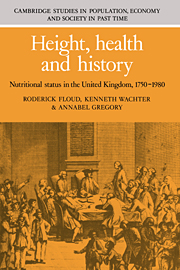Book contents
- Frontmatter
- Contents
- List of figures
- List of tables
- Preface
- 1 Height, nutritional status and the historical record
- 2 Inference from military height data
- 3 Inference from samples of military records
- 4 Long-term trends in nutritional status
- 5 Regional and occupational differentials in British heights
- 6 Height, nutritional status and the environment
- 7 Nutritional status and physical growth in Britain, 1750–1980
- 8 Conclusions
- Bibliography
- Index
7 - Nutritional status and physical growth in Britain, 1750–1980
Published online by Cambridge University Press: 05 November 2011
- Frontmatter
- Contents
- List of figures
- List of tables
- Preface
- 1 Height, nutritional status and the historical record
- 2 Inference from military height data
- 3 Inference from samples of military records
- 4 Long-term trends in nutritional status
- 5 Regional and occupational differentials in British heights
- 6 Height, nutritional status and the environment
- 7 Nutritional status and physical growth in Britain, 1750–1980
- 8 Conclusions
- Bibliography
- Index
Summary
INTRODUCTION
The overall course of change in heights in Britain is fascinating in its historical context. Average male height by birth cohort rose from the middle of the eighteenth century and into the late 1820s, though with a possible check for those born just before and thus growing up in the Napoleonic Wars. Average male heights then began to fall for those born and experiencing childhood in the hungry thirties and continued to fall for the birth cohorts of the 1840s and early 1850s. For those born after the 1860s, reaching adulthood in the 1870s and 1880s, a modest rise occurred, regaining earlier levels only with those born at the start of the twentieth century and then rising more rapidly, especially after the Second World War.
At the same time, there were very substantial changes in the geographical distribution of height. The significant Scottish advantage in height over the rest of the United Kingdom, so apparent in the eighteenth century, was eroded during the nineteenth century and has disappeared entirely in the twentieth. Conversely, the markedly lower heights of Londoners in the eighteenth and nineteenth centuries were replaced by a height advantage which London now shares with the rest of south-east England. Over the period as a whole, the urban areas, led by London, first showed declining heights in relation to rural areas, before demonstrating an increase which has now led, in Britain as in other developed countries, to an urban height advantage.
- Type
- Chapter
- Information
- Height, Health and HistoryNutritional Status in the United Kingdom, 1750–1980, pp. 275 - 324Publisher: Cambridge University PressPrint publication year: 1990

